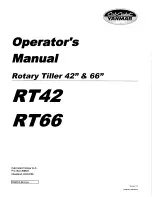
7
Baker Instrument Company
The Measure of Quality
Open Ground Circuit Disable instructions for 6kV, 12kV, and 24kV D
Series Testers.
In a testing environment where no ground can be supplied to the surge tester, the
following steps can be done so that the tester will operate. Read and follow these
instructions prior to proceeding.
1.
Locate and remove the two (2) M4 x 7mm black hex head screws on the front panel.
The first is located above the function switch knob, and the second is below the
seconds/division knob.
2.
Grasp the function switch knob in one hand and the seconds/division knob with the
other hand and pull away from the tester. By doing this the I/O board will no unplug
from the Motherboard.
3.
Locate and remove the two (2) M4 x 7mm black hex head screws on the front panel.
The first is above the open ground lamp socket and the second is below the horizontal
potentiometer knob.
4.
With your fingertips, grasp behind the front panel A/D board assembly and pull away
from the tester. By doing this the Power board will now unplug from the
Motherboard.
Caution: DO NOT damage the potentiometers or cause fractured
solder joints at the legs of the potentiometers
.
5.
Remove the remaining printed circuit board, the Controller board. Grasp at the edges
of this assembly and pull away from the testers front panel.
6.
For the 15kV and 24kV only locate and remove four (4) Phillips screws that secure
the blue top cover to the case assembly. Two (2) will be located on the left side and
two (2) will be located on the right side. This step applies to 15kV, and 24kV models
only. Remove the top cover. Skip to step 10.
7.
For 6kV or 12kV models manufactured before August 1998 which are enclosed in a
blue shock mounted Knurr design case, removal of the inner chassis from the case
will be necessary. If enclosed in a Tan Rittal design case proceed to step 9.
8.
Unlock the rear cover latches and unhinge the rear cover. Locate and remove four (4)
Phillips M4 x 10mm screws. Two are located on the left side and two are located on
the right side. Reinstall the rear cover. Locate and remove the front panel four (4)
M5 x 16mm black hex head screws. Two are on the extreme left edge and two are
located on the extreme right side of the front panel. Grasp the CRT bezel in one hand
and the test leads with the other hand and pull straight out of the Knurr case. Skip to
step 10.








































